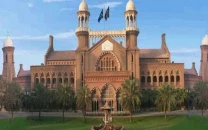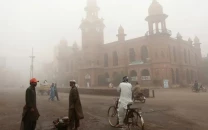Abandoned abode: For the Mehsuds, a long way back for home
Resettled tribesmen remain divided over presence of security forces.

Girls carry blankets distributed by the local army officers in South Waziristan. Majority of the agency’s tribesmen remain displaced since the military operations commenced in 2009. PHOTO: TAHIR KHAN/EXPRESS
Majority of the agency’s tribesmen remain displaced since the military operations commenced in 2009. Mehsuds fled when security forces introduced airpower and ground forces in the October 2009 offensive to rid the area of Tehreek-e-Taliban Pakistan (TTP) militants, as a result of which severe clashes erupted, tribesmen from Sararogha Market told The Express Tribune.
According to them, only 5% of internally displaced persons (IDPs) who fled the initial fighting have returned home with the military’s assistance. The rest continue to live in other cities, awaiting permission and clearance from security forces to return.
Security officials, however, claim nearly 20% of the IDPs have been resettled and more will soon follow once the infrastructure is up and running and facilities restored.
The Mehsud tribe, which constitutes nearly 63% of South Waziristan’s 515,000 inhabitants, resides on one of the world’s most tough and rugged terrains. These mountains were under Taliban control until military operations were launched.
Areas including Ladha, Shakai, Makin, Janata, Sararogha – all the way Southeast up till Jandola – have seen utmost devastation in terms of life and property.
In a few months following the ground offensive, the military claimed victory over Taliban fighters and started the reconstruction process with assistance from international donors and the Federally Administered Tribal Areas (Fata) Secretariat. Roads, water supply infrastructure, education and agriculture were part of the development schemes.
These projects, however, hold little meaning until the displaced Mehsuds are fully resettled and their properties handed back to them. Those who have returned wish others too are allowed to come back in the same manner, considering they have spent quite a few years away from their native land.
In addition to these aspirations, tribesmen are still divided over the presence of security forces in the area. Some fear a relapse if the army withdraws, while others are confident peace will prevail nonetheless.
Sardar Hussain, who lived in Tank and Islamabad during his displacement and has returned to the agency two years ago, said he will leave if the army pulls out.
“I do not trust the civilian administration and will prefer life as an IDP if the security forces decide to withdraw,” Hussain said. “Fighting could erupt [again] after the forces depart.”
Some Mehsud tribesmen who have resettled disagreed with Hussain’s apprehension. They said peace will not be threatened.
“The situation is stable and facilities, including road, hospitals, and water supply schemes are operational. There will be no problems after the armed forces withdraw,” said Muhammad Shoaib, a young IDP who has recently returned home from DI Khan during his displacement.
Shoaib argued that once all Mehsud’s are resettled, the traditional Malik system can be revived for governance and dispute resolutions.
The resettled tribesmen, however, complained of not receiving any monetary compensation as was promised since their return. Some said their homes and shops remain in ruins.
A poster depicting the military’s slogan of ‘Build better than before’ proclaimed that prosperity will dawn on Waziristan. But daunting challenges including the revival of economy and infrastructure lie ahead.
The Pakistan Army claims to have started the resettlement of IDPs in December 2010, when 1,300 families returned home. The pace of resettlement gained momentum thereafter and more than 2,200 families arrived in June 2011. By April 2012, the army claimed 8,177 families or approximately 38,270 individuals had returned home.
But for the time, the 300-kilometre road – ‘South Waziristan’s lifeline’, connecting Tank to Wana; Angor Ada to the west and beyond Sararogha to the north – still wears a deserted look.
Published in The Express Tribune, April 16th, 2013.


















COMMENTS
Comments are moderated and generally will be posted if they are on-topic and not abusive.
For more information, please see our Comments FAQ